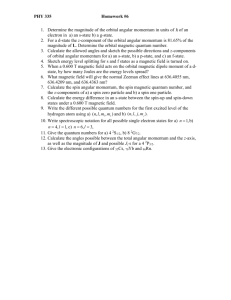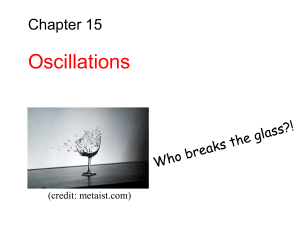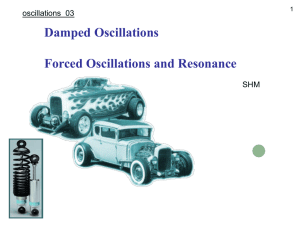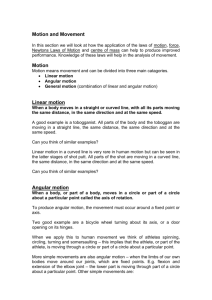Why torsional oscillators?
advertisement
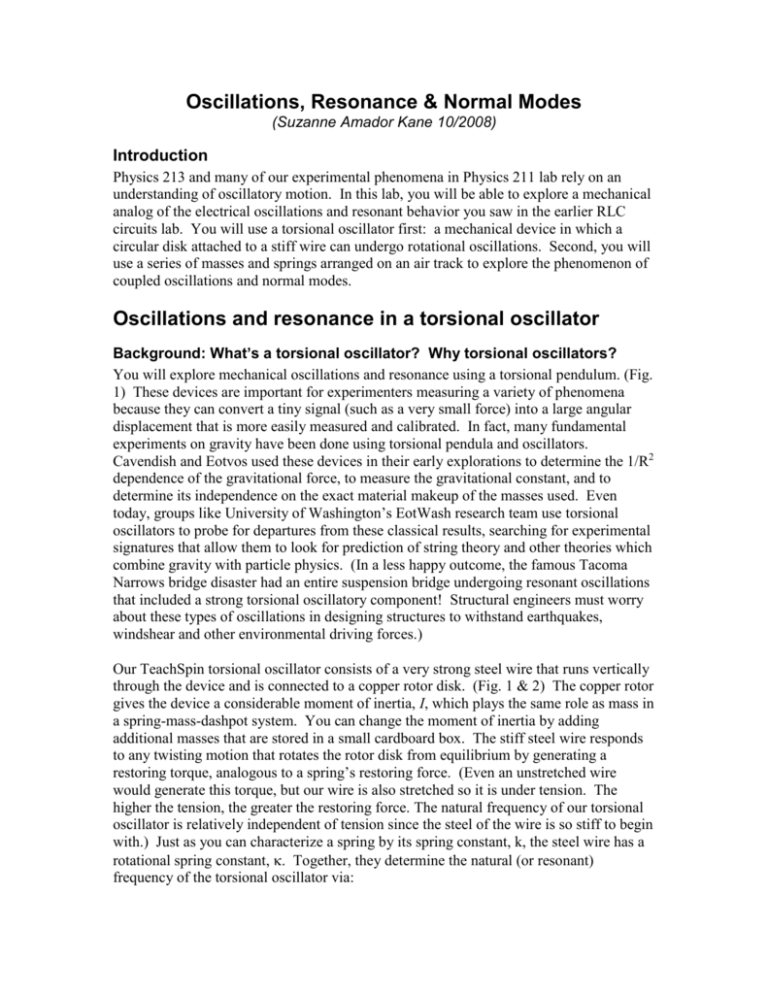
Oscillations, Resonance & Normal Modes (Suzanne Amador Kane 10/2008) Introduction Physics 213 and many of our experimental phenomena in Physics 211 lab rely on an understanding of oscillatory motion. In this lab, you will be able to explore a mechanical analog of the electrical oscillations and resonant behavior you saw in the earlier RLC circuits lab. You will use a torsional oscillator first: a mechanical device in which a circular disk attached to a stiff wire can undergo rotational oscillations. Second, you will use a series of masses and springs arranged on an air track to explore the phenomenon of coupled oscillations and normal modes. Oscillations and resonance in a torsional oscillator Background: What’s a torsional oscillator? Why torsional oscillators? You will explore mechanical oscillations and resonance using a torsional pendulum. (Fig. 1) These devices are important for experimenters measuring a variety of phenomena because they can convert a tiny signal (such as a very small force) into a large angular displacement that is more easily measured and calibrated. In fact, many fundamental experiments on gravity have been done using torsional pendula and oscillators. Cavendish and Eotvos used these devices in their early explorations to determine the 1/R2 dependence of the gravitational force, to measure the gravitational constant, and to determine its independence on the exact material makeup of the masses used. Even today, groups like University of Washington’s EotWash research team use torsional oscillators to probe for departures from these classical results, searching for experimental signatures that allow them to look for prediction of string theory and other theories which combine gravity with particle physics. (In a less happy outcome, the famous Tacoma Narrows bridge disaster had an entire suspension bridge undergoing resonant oscillations that included a strong torsional oscillatory component! Structural engineers must worry about these types of oscillations in designing structures to withstand earthquakes, windshear and other environmental driving forces.) Our TeachSpin torsional oscillator consists of a very strong steel wire that runs vertically through the device and is connected to a copper rotor disk. (Fig. 1 & 2) The copper rotor gives the device a considerable moment of inertia, I, which plays the same role as mass in a spring-mass-dashpot system. You can change the moment of inertia by adding additional masses that are stored in a small cardboard box. The stiff steel wire responds to any twisting motion that rotates the rotor disk from equilibrium by generating a restoring torque, analogous to a spring’s restoring force. (Even an unstretched wire would generate this torque, but our wire is also stretched so it is under tension. The higher the tension, the greater the restoring force. The natural frequency of our torsional oscillator is relatively independent of tension since the steel of the wire is so stiff to begin with.) Just as you can characterize a spring by its spring constant, k, the steel wire has a rotational spring constant, . Together, they determine the natural (or resonant) frequency of the torsional oscillator via: 2 Physics 211 o I , the rotational analogy to o Resonance & Normal Modes (1) k for a spring-mass system m Figure 1: The Teachspin Torsional oscillator. The rotor also is attached to an angular position transducer, which allows you to directly read out the angular position, , as a function of time via a BNC connector on the front panel. You can read out the angle in radians using a calibrated scale glued to the rim of the copper rotor; a clear plastic guide allows you to read out position. (Fig. 3) Your device can also measure angular velocity directly using a clever magnetic system. Also attached to the rotor disk is a set of strong permanent magnets. These have a magnetic dipole moment oriented out of the page in Fig. 2. On either side of these magnets are a set of “Helmholz coils” located just under the copper rotor. Helmholz coils are two sets of circularly wound coils with a common central axis. Our coils are wired so they are both in series and wound in the same orientation (i.e., both are either clockwise or counterclockwise, depending on your perspective. When the entire device rotates, this relative motion between the permanent magnets’ dipole and the Helmholz coils creates an induced EMF in the Helmholz coils that is proportional to the angular velocity of the moving rotor. (They do not interact with the nonmagnetic copper of the rotor however.) By setting a front panel switch, you can measure angular velocity directly by measuring this signal, which is available on the main panel via BNC connections. Our device has been constructed so it can either oscillate freely, or else be driven by an external forcing signal. This external torque is applied using the very same Helmholz coils and permanent magnets described above. You can switch the Helmholz coils so they are connected to two gray BNC connectors on the front panel. A function generator can then be used to apply a driving voltage to these connectors. This results in a timevarying current through the Helmholz coils, which generates a time-varying magnetic field, B, that creates a time-varying torque, d , on the permanent magnets attached to the 3 Physics 211 Resonance & Normal Modes rotor: d = B. This plays the same role as the driving force, Fd, in lecture and your textbook. The driving waveform can be sinusoidal, with a varying amplitude and frequency f d = d /(2, set by the function generator. Figure 2: Detailed view of the central rotor and angular position transducer section. In your Physics 213 lecture and textbook, you have encountered the equations for oscillatory motion using the spring-mass-dashpot system. In our device, we have a similar equation (see your text’s Chapters 3 and 4 for more background). Fundamentally, these equations are just special cases of Newton’s 2nd law for angular motion: net = I = I d 2 / dt 2 where = torque, = angle and = angular acceleration. For our system, the net torque, net , has two components. The first is the restoring torque that results from rotating the rotor from equilibrium, which obeys Hooke’s law for rotational motion: spring where = angular spring constant. The second is a contribution due to the inevitable frictional or damping forces in the environment. The damping in your wire + rotor device is itself very small. However, there are two sets of magnetic dampers installed on either side of the rotor disk. (Fig. 3) These consist of permanent magnets mounted on small translation stages that can either be fully retracted, for essentially no magnetic damping, or translated so as to hover over the copper rotor disk. When the magnetic damping is engaged, the relative motion between the magnetic dampers and the rotating rotor disk generates eddy currents in the copper. This creates a damping torque that is proportional to angular velocity: damping ddt (4) 4 Physics 211 Resonance & Normal Modes Figure 3: Magnetic dampers The resulting differential equation is: o2 o cos d t (5) I Where we have introduced a damping constant /I and we have assumed a sinusoidal driving torque. You have encountered the solutions to the resulting equations of motion in Physics 213. Prelab Exercise 1: Find in your textbook and notes the following relationships to use in your experiment and data analysis. Mathematically these will be the same relationships as you’ve studied before, but you will need to understand how the parameters correspond to make sense of your results in lab. a) The relationship between amplitude and phase vs. driving frequency for a driven torsional harmonic oscillator. b) The phase difference between the driving force and the angular displacement at resonance and at frequencies far above and below resonance. c) The definition of quality factor, Q, and its relationship to the equations and parameters in part a) d) The equation of motion for a damped, undriven oscillator. Your answer should give (t) as a function of time, in tersm of the parameters described above. Experiment 1: Getting acquainted with the torsional oscillator Your first activity will be to get used to the operation of your torsional oscillator by setting it into torsional oscillations. Read through the background section above quickly identifying each of the elements described. First, you will observe free, undriven oscillations with minimal damping. Using the thumbscrews on either side of the rotor, 5 Physics 211 Resonance & Normal Modes retract the magnetic damping magnets as far as possible. (Fig. 3). Then, use the small clamp in the bottom half of the steel wire to rotate the rotor slightly by hand and release it. (Do not exceed 1 radian of motion in your experiments, so as to avoid damaging the apparatus.) Your oscillator should undergo slow (~ 1Hz) oscillations that are easy to see by eye. Now, connect your oscilloscope’s Channel 1 input to the Angular Position BNC output from the front panel. (Fig. 4) You should be able to get a display on your oscilloscope of the sinusoidal output signal, although you may have to use a very long time per division setting (1 sec/div or thereabouts.) This means each sweep of the signal may take a long time to refresh on the oscilloscope screen, so be patient if you do not see a signal for a moment. Figure 4: Front panel connections & switches. You can zero this Angular Position signal so it is centered on GND using the small black knob labeled “Zero Adjust” on the left middle panel. Do so now if it is not centered. In the absence of magnetic damping, you should observe free oscillations with a magnitude that varies little with time. Record your natural frequency, fo, for later reference. Vary the natural frequency by adding additional weights as shown in Fig. 5. Each quadrant weight adds I = kg/m2, where M R12 R22 I (6) 2 Record how the resonant frequency changes as you add each mass, for several different masses. Measure the mass of each with the scale provided and the two radii, R1 and R2 (see Fig. 5) so you can compute I. After you have finished the experiments below, return to this point and use this data to extract the rotational inertia of the rotor disk (without added masses) and the wire’s rotational spring constant. Do this using a plot that utilizes your data for resonant frequency as a function of the number of added masses (or, equivalently, extra I.) Then use a fitting program to deduce Io, the rotor disk’s rotational inertia, and the torsional spring constant, . (For example, think of how you could use a simple linear plot—of what vs. what?-- to extract these parameters.) What are your units and error bars for each quantity? 6 Physics 211 Resonance & Normal Modes Figure 5: Brass quadrant masses for varying rotational inertia Experiment 2: Free oscillations & damping Now, connect Channel 2 of your oscilloscope to the rightmost Angular Velocity BNC output on the Torsional Oscillator’s front panel (Fig. 4). Once again, retract your magnetic dampers fully so you see undamped oscillations. Observe and sketch the time behavior of your Angular Position and Angular Velocity. What is the phase relationship between the angular position and angular velocity? Explain why this does or does not make sense mathematically for simple harmonic motion. Now, use the XY feature of your oscilloscope to make a phase space plot of angular position (X on Ch1) vs. angular velocity (Y on Ch2). Sketch this relationship for undamped (magnetic dampers fully retracted) and for significant damping (magnetic dampers in an intermediate state). Explain why each case looks the way it does. Be sure to sketch the full time behavior, not just one representative point! Now that you are familiar with the basic operation of the experiment, let’s compare its behavior to theoretical predictions. In your RLC laboratory, you were unable to observe the full range of behavior of free oscillations: the response of the system without a driving force. We will do so now and compare the results to theory. In this part of the experiment, you will use the LabPro interface with a voltage probe. Connect this probe to your Angular Position output and to the DIG 1 signal input on the LabPro. Log onto the Logger Pro software package and make sure you are seeing a voltage vs. time plot. Adjust the magnetic damping and the time range on your LoggerPro plots so you can see many oscillations and also see the full effect of damping. (Your plot should look something like Fig. 3-13 in your 213 text, but including both more oscillations and a longer time to see the full effect of damping.) Capture a good set of data, then cut and paste it into Origin to analyze. In Origin, make a plot of your voltage vs. time, then do a fit using your functional form for damped free oscillations. You will be most happy to learn that this function is available (sort of) as part of Origin’s 7 Physics 211 Resonance & Normal Modes collection of fitting functions! (Sort of, because you will have to relate Origin’s parameters to your own. Be sure to write down the fitting function carefully and its parameters names, save the values you fit to, and later figure out how they correspond to your own parameter choices!) Before you do the fit, it’s a good idea to subtract off any nonzero y-offset. That’s because the voltage from the Angular Position transducer is hard to zero exactly. Do this by selecting the column with Angular Position in Origin, then choosing Statistics/Descriptive Statistics/Statistics on Columns. This computes the mean, which you can subtract off your data by selecting the appropriate column, rightclicking on it and using the Set Column Values option to subtract off the nonzero offset. To do the fit, go to Analyze/Nonlinear Curve Fit/Advanced Fitting Tool/Waveform/Sine damp. That function (Sine damp) is the one you wish to use. Again, write down the function and its parameter names. Perform a fit to your actual experimental data and record the best fit parameters; plot out your best fit along with the experimental data all on one plot. (You may have to make good guesses at the initial amplitude and other parameters to get the fit to resemble your data, so be sure to record all your work. Ask your instructor for help if you have a hard time with this part!) In your final report, explain the meaning of your fitting parameters by relating them to those used in your textbook’s description of damped free oscillations, such as Eq. 3-34(c). See if you can also capture critically damped oscillations by adjusting the magnetic damping. (See your text pp. 52-53.) Don’t spend too much time getting it perfect! Print out your best result. Experiment 3: Forced oscillations & resonance Now you will use a function generator to drive oscillations. Be sure you have noted the natural frequency of resonance of your oscillator (without any additional masses) before you move on to this part. Start with the magnetic damping retracted so that you have the dampers just clearing the rotor, for light damping. (If you fully retract the dampers, we have found that you will excite both torsional oscillations plus a guitar-string like vibration of the wire. Your angular position vs. time signal will then exhibit beating as energy feeds between these modes with very similar resonant frequencies. This was discovered by two students, Jennifer Campbell and Alex Cahill in 2008!) Connect one of the newer (gray not black) Wavetek function generators so its LO voltage output is connected to the Coil Drive via a BNC cable to banana plugs. (See Fig. 4) (You will not want to use the HI output, since it will drive your oscillators’ oscillations too strongly! You may instead need to use the attenuation feature rather than choosing the LO vs. HI output. The gray Wavetek function generators have frequency select dials with a digital readout, for better resolution in finding and hence Q.) Set the Torsional Oscillator’s toggle switch to its left side to connect the Helmholz coils to the drive circuitry. Use a BNC tee connector so you can monitor the driving voltage on an oscilloscope on Channel 2. Continue to monitor the Angular Displacement signal on Channel 1 of your oscilloscope. Again, you will want to use a time/division of about 1 second or so. 8 Physics 211 Resonance & Normal Modes Drive the oscillations with a sinusoidal signal, with an initial frequency close to the natural frequency of your torsional oscillator and starting at about half the full amplitude. In the RLC Circuit Lab, we had you make a detailed plot of the dependence of amplitude and phase on driving frequency. Here, you will spot check that the same behavior holds, using your Prelab Exercise Results as a guide. Hint: Make sure to stop the vibrations in between each frequency measurement, or otherwise it will take too long! 1) Drive the system at as close to the natural frequency as possible, with minimal magnetic damping. Then, find & record the frequency at which the system gives a maximum oscillatory amplitude. Record the phase difference between the driving signal and the oscillation. (For this part, make sure your drive signal has the BNC-to-banana plug oriented so the banana plug with the grouncing notch is uppermost. This ensures the right orientation of the voltage so your oscilloscope display of driving voltage is in phase with the driving torque.) Which signal leads and by how much in radians or degrees? Does this agree with your expectations? Refer to your plot from the PreLabs. 2) Now go to higher and lower frequencies and record the phase shift at each extreme, recording all your values. Again, compare to your expectations. 3) Estimate Q by changing the drive frequency to see the correct (approximate!) drop in angular position amplitude to 1/2 the peak value. (Recall from the RLC circuits lab, Q = o/.) Don’t spend too much time on this part—it’s a very narrow frequency range! You will have to stop the oscillator by hand at each frequency after exciting it at the resonant frequency, rather than allowing it to slowly decay to equilibrium at the new frequency off-resonance. 4) To see the effect of damping on Q as the magnetic damping is varied, measure Q as in part 3 for a moderately damped oscillator. Discuss how your data compares with expectations. Troubleshooting: 1. Is your frequency range set to 1 Hz? 2. Did you remember to flip the switch on the torsional oscillator panel to its left side? If it’s not set properly, you haven’t connected the function generator to the drive torque circuitry. 3. Did you connect the Angular Position output from the oscillator back to the oscilloscope (in the last experiment, you connected it to the LabPro cable)? Experiment 4: Coupled Oscillations and Normal Modes One very important class of oscillatory behavior occurs when two or more objects are coupled together by springs (or by forces that act approximately spring-like for small displacements—such as atomic vibrating about their chemical bonds!) You have seen in lecture and your textbook that this case can be analyzed to yield predictions for normal modes: collective motions of the system as a whole that can be related to the spring constants and masses of the individual objects. In lab, you have an airtrack that blows forced air from its length. Several small sleds can freely slide along its length. Two such sleds are mounted such that they have springs connecting them, and each is connected by 9 Physics 211 Resonance & Normal Modes a spring to a fixed mount on each end of the rail. (It looks like this photo from: https://wiki.brown.edu/confluence/display/PhysicsLabs/Experiment+120 ) Prelab Exercise 2: Look up in your notes or your textbook for Physics 213 the predictions for the frequencies of oscillations of the normal modes of two identical masses, m, coupled by identical springs with spring constant k, in terms of k and m. If you do not know how to do this, either consult the similar derivation for two coupled pendula, or else consult with your instructor forishow to derive this. The driving mechanism a rotating shaft connected to a rod that wags back and forth as the shaft rotates. This shakes one of the end springs, driving the motion of the coupled masses. A DC motor creates the rotational motion; it is driven by a DC power supply. You can adjust the driving frequency by changing the DC voltage output. The two normal mode frequencies correspond to approximately 5.7 and 8.7 volts. (But, don’t change the drive voltage too fast! Remember, a motor is also an inductor, so you wish to change the voltage across it slowly. Also, always reduce the power supply voltage to zero before turning off the supply! The spike of voltage across the (inductive) motor could burn out the power supply otherwise. Also, do not use a voltage greater than 12V with the motor, even though your supply can go higher than this. Since the voltage increases abruptly after 12V, be extra careful about this!) You can measure the frequency of the driving force using the photogate system and its output box. (See figure below from Pasco™. This system works by using a black U-shaped piece mounted close to the rotating driving arm. As the arm rotates, it blocks a light beam that shines from one end of the U to the other. This is detected by the photogate box, which records the period. You will need to Select Measurement: Time, then Select Mode: Pendulum mode, then press Start/Stop to get this reading. (The power switch is inconspicuously located on the left side!) Record both the driving voltages and a few values of the period to get the frequencies of each normal mode and the associated uncertainties. 10 Physics 211 Resonance & Normal Modes In your writeup, compare the approximate ratios of your two normal mode frequencies with your theoretical estimate from Prelab Exercise 2. Sketch the motion of the two masses in each normal mode, indicating which has the higher frequency. The frequency comparison will be qualitative, but you should be able to check the approximate correspondence.
